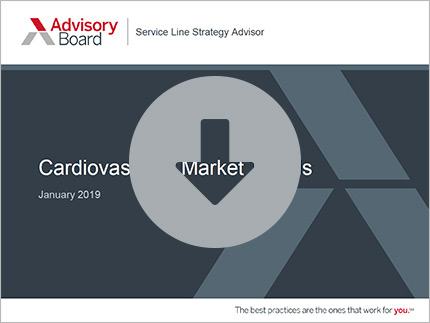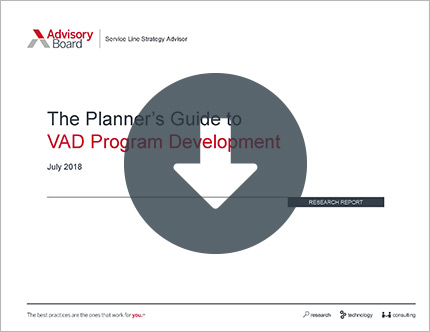Auto logout in seconds.
Continue LogoutWider use of extracorporeal membrane oxygenation (ECMO) machines has saved some patients from an otherwise certain death—but it can also leave people who have no chance of recovery in a medical limbo, Melissa Bailey reports for Kaiser Health News.
Read our primer to learn about growth drivers and program development considerations for ECMO
What is ECMO?
ECMO is an aggressive form of life support that pumps blood out of a patient's body, oxygenates it, and then returns it back to the body. The technology can keep a person alive for months, even if their heart and lungs aren't working, Bailey writes.
The machine originally was developed in the 1970s and has been primarily used for newborns. But use among adults began to climb after a clinical trial in 2009 showed positive results among adults with severe respiratory failure.

Ready-to-present slides: Cardiovascular market trends for 2021
In the United States, ECMO use tripled from 2008 to 2014 to almost 7,000 procedures, according to the Agency for Healthcare Research and Quality (AHRQ). Similarly, the number of hospitals offering ECMO has more than doubled since 2008, from 108 to 264, according to a registry run by the Extracorporeal Life Support Organization (ELSO).
Kenneth Prager, director of clinical ethics at Columbia University Irving Medical Center, said ECMO is creating "an entirely new paradigm. You have a heart that's not working, yet the patient is not dead."
But ECMO comes at a steep price, Bailey writes. According to the AHRQ, median charges for ECMO in 2014 were $550,000, which made it the 15th most-expensive procedure that year.
And many ECMO patients never experience any meaningful recovery. ELSO data show that just 29% of patients around the globe who receive ECPR (ECMO for cardiopulmonary resuscitation) survive, while 59% of patients receiving ECMO for their lungs survive, as do 42% of those receiving ECMO for their heart.
Bailey highlights four patient case studies that show ECMO's near-miraculous potential—and its often-disappointing reality.
The best-case scenario: A 'big shocker' recovery
Jessica Zitter was working in the ICU of a hospital in Oakland, California, when a 60-year-old patient came in after a heart attack, Bailey writes. According to Zitter, the patient's heart went into ventricular fibrillation, wiggling like "a bag of worms."
Hospital staff spent hours trying to revive the patient's heart before calling in an ECMO team from another hospital. By the time the team arrived, seven hours had passed since the patient first coded. Zitter said she wasn't optimistic the patient would survive—but to her amazement, he was able to recover and go home.
Zitter said the case was a "big shocker," but cautioned it was "a crazy, crazy, crazy outlier case with a crazy, crazy, crazy outlier response."
A harder outcome: The patient who never recovered
Not all cases are such a success. For example, Haider Warraich of Duke University Medical Center told Bailey about a patient who'd recently undergone a lung transplant and had collapsed from a heart attack. The man's heart was lacking oxygen and had sped into a malignant rhythm, Bailey writes, and he didn't respond to CPR or electric shocks.
Doctors elected to place the patient on ECMO, giving cardiologists time to perform surgery to unblock the patient's artery. Ultimately, though, the surgery was not successful. The man died after a month on the ECMO machine before he died.
Warraich said he felt using ECMO was appropriate in that case, but said doctors need more guidance on how to determine whether a patient would benefit from the machine. "If you have someone who is dying in front of you, it's really hard to step back and think about it," he said.
An agonizing scenario: The 'bridge to nowhere'
As Bailey reports, ECMO is "not designed to be a destination, but a bridge to somewhere," giving providers enough time to help a patient recover or receive a transplant or an implanted heart device.
However, when it's applied to patients who aren't ultimately able to receive any of these procedures, "ECMO can become a 'bridge to nowhere,' leaving the patient in limbo, possibly even awake and alert, but with no chance of survival outside the [ICU]," Bailey writes.
For example, a case report by Robert Truog, director of the Center for Bioethics at Harvard Medical School, in The Lancet described a 17-year-old boy who came to the ICU at Boston Children's Hospital in end-stage respiratory failure. The patient had already had one lung transplantation for cystic fibrosis and needed a new set of lungs, so the patient was placed on ECMO as a bridge therapy while he awaited his transplant, Bailey writes.
During this time, the patient was fully conscious, able to do homework, visit with friends and family, and text his friends. However, after two months in the ICU, the patient was diagnosed with untreatable cancer, making him ineligible to receive new lungs—and leaving doctors at a difficult crossroads.
Some doctors wanted to stop the ECMO treatment since the transplant was no longer possible, while others argued that the patient seemed to have a good quality of life inside the ICU, Truog wrote.
Ultimately, clinicians and the patient's family came up with an alternative: They elected not to replace the ECMO oxygenator, which needed to be changed every week or two once it developed blood clots. Without the replacement, the machine gradually failed over the course of a week, and the patient eventually lost consciousness and died, Truog said.
This "allowed him to die in a way where we didn't feel like we were choosing the moment of his death," Truog said.
A traumatic outcome: The patient who suffered PTSD
In other cases, doctors have found leaving patients on ECMO may cause trauma, as was the case with Philip Ayoub. After undergoing his third bypass surgery in December 2017, Ayoub experienced a series of mini-strokes, lost consciousness, and was transferred to Irving Medical Center, where he was placed on ECMO at his wife's request.
When he woke up, he asked his wife, Karen Ayoub, "Why am I here?" Ayoub's only treatment option was an implanted device to help his heart pump, but he grappled with whether or not to have the procedure—and eventually, so much time had passed that he became ineligible, Karen said.
In total, Philip spent two months in the ICU on ECMO. During that time, Karen said her husband began to experience post-traumatic stress disorder, along with night terrors and side effects from his medication. While Karen called the extra time together "a gift," if the situation were repeated, she said she's unsure whether her husband would have wanted to be on ECMO. "[H]e was the one laying in that bed for two months, being tortured by needles and night visions," she said.
Daniela Lamas, a critical care doctor at Brigham and Women's Hospital, said she sees both the potential and the limitations of ECMO.
"With every escalation and fancy machine comes a lot of hope," she said. "It's really hard to temper that hope with the realities that with each new thing comes a host of ethical questions and dilemmas."
ECMO, she said, is "a fantastic example of 'just because you can, doesn't mean you should'" (Bailey, Kaiser Health News, 6/18).
Your guide to ECMO program investment and development
Recent uptick in ECMO (extracorporeal membrane oxygenation) adoption nation-wide has increased provider interest in building ECMO programs. But ECMO may not be the right investment for every hospital due to its high start-up costs and complex, resource-intensive patient population.
Read our primer to learn about why ECMO utilization is growing and understand the investments in infrastructure; staff and care coordination; and program governance and referral strategy necessary to program success.
Don't miss out on the latest Advisory Board insights
Create your free account to access 1 resource, including the latest research and webinars.
Want access without creating an account?
You have 1 free members-only resource remaining this month.
1 free members-only resources remaining
1 free members-only resources remaining
You've reached your limit of free insights
Become a member to access all of Advisory Board's resources, events, and experts
Never miss out on the latest innovative health care content tailored to you.
Benefits include:
You've reached your limit of free insights
Become a member to access all of Advisory Board's resources, events, and experts
Never miss out on the latest innovative health care content tailored to you.
Benefits include:
This content is available through your Curated Research partnership with Advisory Board. Click on ‘view this resource’ to read the full piece
Email ask@advisory.com to learn more
Click on ‘Become a Member’ to learn about the benefits of a Full-Access partnership with Advisory Board
Never miss out on the latest innovative health care content tailored to you.
Benefits Include:
This is for members only. Learn more.
Click on ‘Become a Member’ to learn about the benefits of a Full-Access partnership with Advisory Board
Never miss out on the latest innovative health care content tailored to you.

